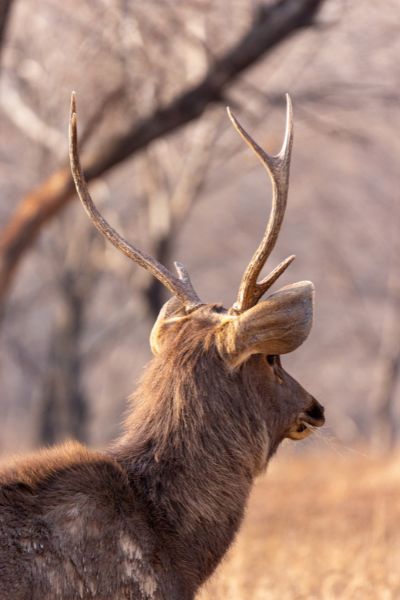Ranthambore National Park is around 13.5 kilometres from Rajasthan’s, Sawai Madhopur. Because wild animals are accustomed to seeing, this region at the confluence of the Aravalli and Vindhya mountain ranges is one of the greatest places to see them. The park is roughly 400 square kilometres in size, with the Sawai Man Singh Sanctuary region adding another 500 square kilometres.
The buildings in Ranthambore National Park harken back to a bygone period. Throughout the park, several water features give great relief to the wild animals during the searing hot summer days. The park is known to have a huge fort that rises above the area.
The forest is littered with remnants of old times, giving it a distinctive, beautiful and blended taste of nature, history and fauna. Tigers have been seen hunting in front of human tourists in Ranthambore National Park.
Ranthambore Tiger Reserve has a long and illustrious history
The Government of India created Ranthambore National Park in 1955 as the Sawai Madhopur Game Sanctuary. It was designated as a Project Tiger reserve in India in 1973. Ranthambore National Park was established on November 1, 1980, together with Sawai Man Singh Sanctuary and Keladevi Sanctuary, which are located nearby.
History of Ranthambore Tiger Reserve


The Government of India created Ranthambore National Park in 1955 as the Sawai Madhopur Game Sanctuary. It was designated as a Project Tiger reserve in India in 1973. Ranthambore National Park was established on November 1, 1980, together with Sawai Man Singh Sanctuary and Keladevi Sanctuary, which are located nearby.
How to Reach Ranthambore Tiger Reserve?
By Air
Ranthambore is around 200 kilometres from Jaipur International Airport, which is the closest airport. Taxis and private automobiles may be hired to get to the park from the airport.
By Railways
Ranthambore National Park is around 14 kilometres from Sawai Madhopur Railway Station, which is the nearest railway station. Around 200 kilometres away from the park lies Jaipur Railway Station. Both locations are well connected by train to India’s main cities.
By Road
The National Highways 11A and 8 connect Ranthambore to Delhi, while NH 76 connects it to Udaipur and Allahabad. Ranthambore is linked to Jaipur via SH 24, while Agra and Bharatpur are linked by SH 1. The Ranthambore National Park is 381 kilometres from Delhi, 239 kilometres from Agra, 388 kilometres from Udaipur, and 1031 kilometres from Mumbai.
Bird watching in Ranthambore
Ranthambore is an important birding destination in India since it is home to a huge number of birds in addition to a diverse range of wildlife. Serpent eagle, waterfowl, cormorant, painted spurfowl, sarus crane, bronzed-winged jacana, sandpiper, kingfisher, nightjar, painted sandgrouse, and great-horned owl are among the 320 species of birds found in the national park in Rajasthan, which is known for being a natural habitat for the Royal Bengal Tiger. In the winter, a huge number of migrating birds make Ranthambore and its wetlands their home, providing bird watchers and ornithologists plenty of reasons to visit the national park. The region around the three huge lakes – Padam Talao, Malik Talao, and Rajbagh Talao – is home to the majority of the birds.
Asian Palm Swift, Woodpeckers, Nightjars, Indian Gray Hornbills, Common Kingfishers, Bee Eaters, parakeets, Owl, Pigeon, Dove, Crakes, Snipes, Sandpipers, Gulls, Terns, Great Crested Grebe, Eagles, Darters, Cormorants, Egrets, Herons, Bitterns, Flamingos, Ibis, Graylag Goose, Cuckoos
Photography


Flora in Ranthambore National Park
The topography of Ranthambore’s famed national park fluctuates between dry deciduous trees and wide grassland meadows. Ranthambore National Park is home to 539 different blooming plant species. The Dhok tree is the most common type of tree found in the national park, but other tree species such as mango, tamarind, and banyan can also be found in abundance. Jogi Mahal, located near Ranthambore, is home to one of India’s biggest banyan trees.
Ranthambore online safari
Ranthambore National Park, one of India’s greatest, is well-known for its tiger sightings. If you’re planning a trip to Ranthambore National Park for a thrilling wildlife tour and are seeking information on Ranthambore do the online safari booking right now , By filling out the form, you can learn more about our action-packed holiday packages, sightseeing excursions, and hotel reservations in Ranthambore.
Conclusion
Ranthambore National Park is regarded as one of the country’s best tiger reserves. This lovely site may be reached by air, rail, or road. People from all over the globe come here to see the magnificent beauty of the Tigers, flora, and fauna. The jeep safari is an exhilarating event that should be on everyone’s holiday wish list.



